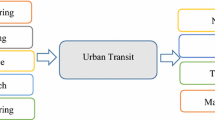Abstract
In this paper, a method of urban terminal network location based on cellular automaton and genetic algorithm is proposed for the lack of scientific and standardized evaluation system in urban terminal network location problem. In this method, on the basis of considering the influencing factors, location principles and location steps of network location, the location model of urban terminal based on cellular automaton is established. To evaluate layout of urban logistics terminal, an evaluation index of competitiveness is built up. Then, calculation method based on logic of the genetic algorithm is used to solve the optimization result of layout through the comparison of the evaluation index. Finally, the effectiveness of the proposed method is illustrated through the simulation based on the actual data from an express company.








Similar content being viewed by others
Explore related subjects
Discover the latest articles, news and stories from top researchers in related subjects.References
Awasthi A, Chauhan S, Goyal SK (2011) A multi-criteria decision making approach for location planning for urban distribution centers under uncertainty. Math Comput Model 53(2):98–109
Silva FJ, de la Figuera DS (2007) A capacitated facility location problem with constrained backlogging probabilities. Int J Prod Res 45(21):5117–5134
Zhuge D, Shucheng Yu, Zhen Lu et al (2016) Multi-period distribution center l-ocation and scale decision in supply chain network. Comput Ind Eng 101:216–226
Chen YC (2002) An application of fuzzy set theory to the external performance evaluation of distribution centers in logistics. Soft Comput 6(1):64–70
Georgiadis MC, Tsiakis P, Longinidis P, Sofioglou MK (2011) Optimal design of supply chain networks under uncertain transient demand variations. Omega 39:254–272
Sadjady H, Davoudpour H (2012) Two-echelon, multi-commodity supply chain network design with mode selection, lead-times and inventory costs. Comput Oper Res 39:1345–1354
He J, Huang Y, Chang D (2015) Simulation-based heuristic method for container supply chain network optimization. Adv Eng Inform 29:339–354
Yolmeh A, Salehi N (2015) An outer approximation method for an integration of supply chain network designing and assembly line balancing under uncertainty. Comput Ind Eng 83:297–306
Asian S, Nie X (2014) Coordination in supply chains with uncertain demand and disruption risks: existence, analysis, and insights. IEEE Trans Syst Man Cybern Syst 44:1139–1154
Zhuge D, Shucheng Yu, Zhen Lu, Wang W (2016) Multi-period distribution center location and scale decision in supply chain network. Comput Ind Eng 101:216–226
Acknowledgements
This work was supported by “National Natural Science Foundation of China (Grant No. 71461026)”, and “13th Five Year Plan of Jilin Provincial Department of Education (2018)”.
Author information
Authors and Affiliations
Corresponding author
Additional information
Publisher's Note
Springer Nature remains neutral with regard to jurisdictional claims in published maps and institutional affiliations.
About this article
Cite this article
Cui, C., Xu, Q. Optimization of urban logistics terminal distribution based on cellular automaton model. Artif Life Robotics 27, 142–148 (2022). https://doi.org/10.1007/s10015-021-00722-x
Received:
Accepted:
Published:
Issue Date:
DOI: https://doi.org/10.1007/s10015-021-00722-x




